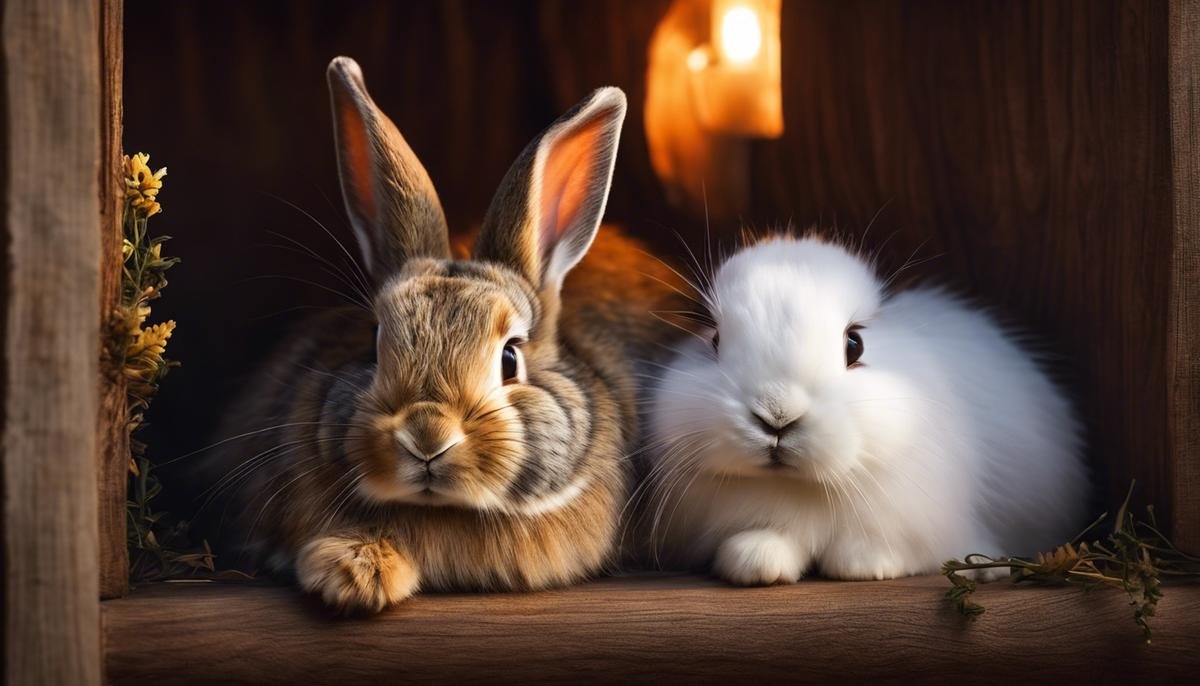Rabbits are enchanting creatures, renowned not only for their charming looks but also for their unique behaviors, which include intriguing sleeping habits. Understanding where rabbits sleep is a facet of rabbit care that is often overshadowed by their more active behaviors. Whether nestling in the wild underbrush or snuggling into a cozy hutch, rabbits have specific preferences for their rest zones. This exploration of rabbit sleeping areas will unveil the various havens rabbits choose as their sanctuaries of slumber. Delving into the wondrous world of rabbit sleep behaviors, we unlock the mystery of when and how these crepuscular creatures catch their Z’s. By the end of this exposition, rabbit owners will be equipped with the knowledge to replicate a rabbit’s natural sleeping environment, ensuring that their furry companions enjoy the comfort and security they require during their resting hours.
Rabbit Sleeping Areas
Discovering the Ideal Snooze Spots for Rabbits: Uncovering Their Sleeping Preferences
Understanding where rabbits prefer to sleep enhances their well-being and contributes to a harmonious living situation. These crepuscular creatures, most active during dusk and dawn, cherish comfort and security for their rest periods. Contrary to common belief, rabbits often forgo the idea of traditional ‘beds’ and instead seek out soft, secluded areas that offer safety from potential hazards.
The typical house rabbit opts for a rest area that mimics the protective burrows of their wild counterparts. A quiet corner, hidden from high traffic and noise, often becomes their chosen retreat. Providing a cardboard box or a commercially available pet house can fulfill their need for a contained space. Line this area with hay or soft, washable bedding to ensure a cozy environment conducive to relaxation. Caregivers should note that rabbits enjoy a clean and dry habitat, so regular maintenance of the sleeping quarters is crucial for the animal’s health and happiness.
Placement of the sleep area within the home requires consideration of the ambient temperature. Rabbits thrive in a cool environment, with optimal temperatures ranging between 60 to 70 degrees Fahrenheit. Avoid placing their designated snooze spot near heat sources, such as radiators or direct sunlight, which may lead to overheating and discomfort. By observing these guidelines, one can provide a sanctuary suitable for a rabbit’s restful slumber, without the need for excessive embellishments or enclosures.

Rabbit Sleep Behaviors
Understanding the Sleeping Patterns of Rabbits
Rabbits are intriguing creatures with unique habits, and their sleep patterns are no exception. Unlike humans, rabbits are crepuscular, meaning they are most active during the twilight hours of dawn and dusk. This behavior influences their sleep schedule. Typically, rabbits sleep for approximately 8 to 11 hours per day, although this can be spread out in shorter, intermittent periods of rest rather than one long slumber. It’s during the day and later at night when these animals take their repose, adopting various postures that can range from a casual, dozy lounging to a more tucked-in position.
Pet owners might notice that even when rabbits appear to be sleeping, they remain alert; a survival instinct that helps them to wake instantly at any sign of danger.
It can be quite enchanting to observe the subtle signs of a rabbit slipping into a snooze, their eyelids gradually closing as they settle into a comfortable spot. When a rabbit reaches the deeper stages of sleep, it may exhibit REM (Rapid Eye Movement), evidenced by the flickering motion of its eyes beneath the closed lids, similar to what people experience. It’s thought that during this REM phase, rabbits can dream, although it remains a charming mystery as to what a rabbit’s dreams may entail. While the total amount of REM sleep rabbits need has not been thoroughly researched, it’s clear they have a daily requirement for both light and deep sleep to maintain their health and well-being.
The sleepscape of a rabbit speaks volumes about its comfort and security in its environment. Observing a rabbit in the throes of peaceful sleep serves as a testament to the tranquility of its surroundings, indicative of a well‑cared‑for pet. Therefore, ensuring that they have a serene spot for slumber is essential, a quiet refuge within their enclosure where they can drift off undisturbed. Creating such an environment not only fulfills their physical need for rest but also fosters a deeper bond between the pet and its human, as the rabbit grows to trust the safe haven provided.

Creating Comfortable Sleep Environments for Rabbits
Ensuring your pet rabbit has a comfortable and cozy sleep environment is fundamental for its well-being. Just like their wild ancestors, domestic rabbits also require a warm and secure area to rest and rejuvenate. While already understanding the basis of their needs, it’s also essential to delve into the intricacies of their sleep patterns to curate the perfect snug sanctuary for their slumber.
When designing a sleep haven for a pet rabbit, it’s crucial to factor in their natural sleep postures and habits. Rabbits often prefer to lie down with their legs tucked under their bodies or stretched out when they’re feeling relaxed and secure. In order to support these natural positions, ensure that their resting area is spacious enough to allow for such flexibility in posture. Additionally, incorporating a soft and flat mat within their designated sleep zone can encourage these relaxed postures and enhance their comfort.
The ambient environment plays a pivotal role in a rabbit’s sleep quality. A peaceful atmosphere, away from loud noises and startling disturbances, promotes a serene setting for your pet to snooze in peace. Moreover, because rabbits are such sensitive and perceptive animals, keeping their resting space in a quiet corner of the home can help minimize stress, leading to more restorative sleep. To further foster an air of calmness, incorporating gentle background noise, like a soft fan or quiet music, can mask disruptive sounds and soothe a rabbit as it dozes.
In summary, creating a cozy sleep environment for pet rabbits involves accommodating their resting habits, ensuring ample space and comfort, and maintaining a tranquil atmosphere. By bearing in mind the nuances of a rabbit’s need for relaxation, pet owners can provide an impeccable haven where their furry companions can indulge in the bliss of undisturbed rest. With the ideal setting, rabbits can enjoy the benefits of a good night’s sleep, crucial for their overall health and happiness.

Providing a secure and serene sleeping environment for rabbits goes beyond the basics of pet care; it is a loving gesture that aligns with their natural inclinations and promotes their overall well-being. As we have traversed through the various aspects of rabbit sleep—from their favored sleeping spots to the quirks of their sleep patterns—it becomes clear that these adorable animals have unique needs that deserve attention. By embracing the responsibility of creating a comfortable sleep environment, pet owners foster a nurturing habitat that allows rabbits to thrive. For both the wild and the companion rabbit, sleep is an integral part of life’s rhythm, and through our understanding and action, we have the power to make each restful moment as tranquil and restorative as it should be.



